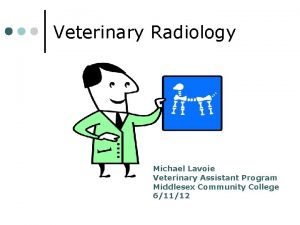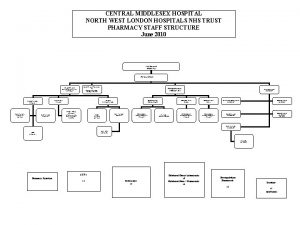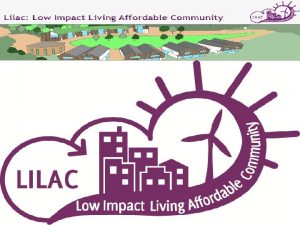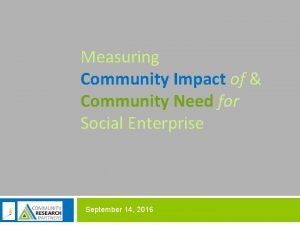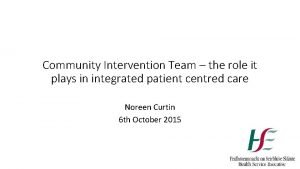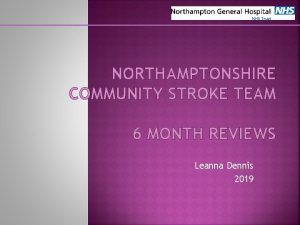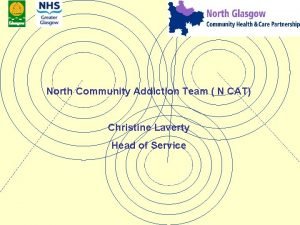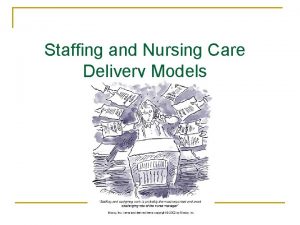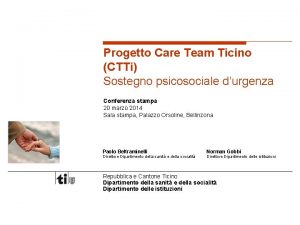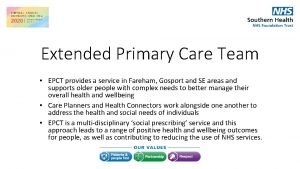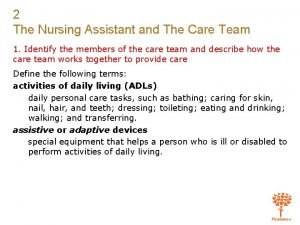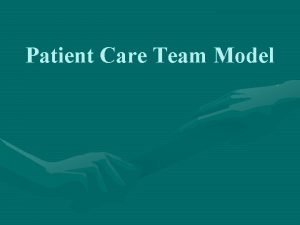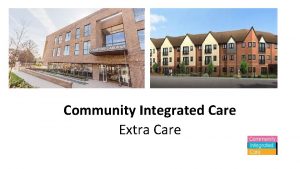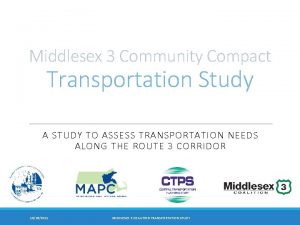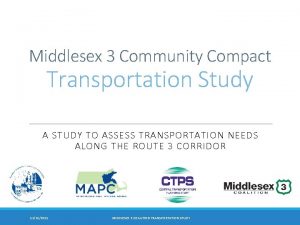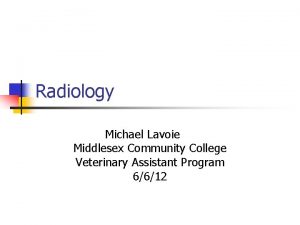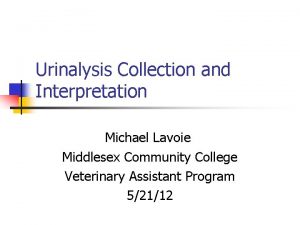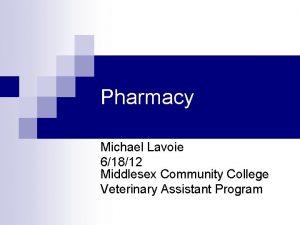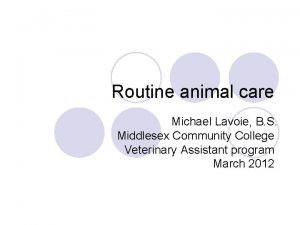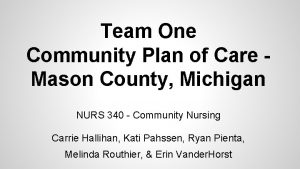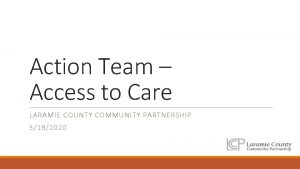Middlesex County Community Care Team The Impact of
























- Slides: 24

Middlesex County Community Care Team: The Impact of Care Coordination Across Providers Connecticut Coalition to End Homelessness 15 th Annual Training Institute May 18. 2017 Terri Di. Pietro MBA, OTR/L Lydia Brewster Administrative Director Behavioral Health Assistant Director for Community Services Middlesex Hospital St. Vincent De. Paul Middletown 1

CHA Community Service Award • https: //vimeopro. com/cthosp/connecticuthospital-association/video/68695816 2

A Community Collaboration 3

A National Crisis: Emergency Department Perspective Fraying of behavioral health systems Increasing numbers of high-risk, highneed behavioral health patients (BHPs) without adequate inpatient or outpatient care BHPs wind up in EDs (our medical system’s safetynet), often with long length of stay BHPs overwhelm EDs’ capacity to care for all ED patients Result: - ED crowding - Decreased safety - Financial losses Needed: a different model of care 4

A Closer Look…The Major Challenge of BH Super Users This population does not get better with the traditional model of episodic care delivery “Falling through the cracks” Required: Care Coordination Question Uncovered Along the Way: How is the experience different for the homeless and those experiencing fragile housing? 5

Middlesex County CCT History • Mental Illness Substance Abuse • project through Rushford (grant funded by state) a continuing care team for dual • diagnosis • Strong relationships were developed 1990 s Middlesex Hospital conducted a health assessment Hospital priority area: access and coordination of care for mental health and substance abuse population 2007 • Middlesex County initiated the 10 Year Plan to End Homelessness; a component was the formation of a community care team • Without a designated champion, the team was never formed 2008 2010 • • Mdsx County CCT is formalized • Expanded to 9 agencies Weekly meetings Health Promotion Advocate is added to Mdsx Hospital ED (through CHEFA grant) 2012 • Mdsx County Community Care Team (CCT) was developed; Mdsx Hospital agreed to be the organizer • 4 core agencies: Middlesex Hospital, Gilead, Rushford, RVS • Met on a monthly basis • Barrier addressed: common Release of Information (ROI) • • Mdsx County model for the CCT was identified as best practice in January 2014 CT Legislative Program Review & Investigatoins Committee Report (Hospital ED Use and Its Impact on the State Medicaid Budget) 2013 - on Dissemination efforts re: Mdsx County model for the CCT DMHAS grant continues the funding for HPA 2014 2015 2016 2015: • Mdsx County CCT is expanded to 13 agencies • Mdsx Hospital outpatient case manager is added to the team 2016: • Mdsx County CCT is expanded to 14 agencies 6

Middlesex County CCT Agency Members • • • • Building Communities of Care as Partners in Practice Middlesex Hospital River Valley Services Connecticut Valley Hospital (Merritt Hall) Rushford Center, Inc. Mdsx CCT The Connection, Inc. Hospital Patients St. Vincent de Paul Soup Kitchen Mercy Housing Columbus House Chrysalis Center, Inc. Community Health Center Gilead Community Services, Inc. Advanced Behavioral Health Case/care management agencies Beacon Health Options, Connecticut Community Health Network Mdsx County Community BH & Social Services 7

Middlesex County CCT Guiding Principles • Objective: To provide patient-centered care and improve outcomes by developing wrap-around services through multi-agency partnership and care planning • Core belief: Community collaboration is necessary to improve health outcomes • Core understanding: Psycho-social problems are community problems. No one entity alone can effectively improve outcomes for this population 8

Middlesex County CCT Program Development • Weekly meetings (1 st meeting: March 27, 2012); for 1 hour – In year 1, individual patient utilization ranged from 12 -80+ ED visits in past 12 months • Expansion of CCT Release of Information form (required for each patient) • Developed process for patient selection • Health Promotion Advocate (HPA) position; HPA is: – only added labor resource • Grant funded in 1 st year by CHEFA (Connecticut Health and Educational Facilities Authority) • Continued/expanded by DMHAS Grant Conversion from year 2 - on – – care coordination & case management direct & indirect referrals to treatment link between: patient – ED – CCT – community services does “check in” calls for those in community who are stabilized or still struggling 9

Middlesex County CCT Process Step 3 – Added to CCT Agenda: • Once ROI is signed, patient is added to CCT agenda and hospital visit history is developed Step 1 - Patient Identification: • Patients are only removed from • ED visit threshold (# of visits & behavioral diagnoses) agenda due to 1) moving out of area/state or 2) death • Daily ED discharge reports (5+ visits in 6 months) • Chair of Emergency Services dictates ED Care Plan for ROI to be signed • Health Promotion Advocate referral • CCT member referral 3 2 1 5 Step 5 – Follow-Up: • Continued follow-up on after -care plans 4 • Rapid team intervention when exacerbation of illness Step 4 – Weekly Meetings: occurs after a period of • Team meets on a weekly basis stabilization to discuss & care manage new/on-going patients Step 2 - Patient Interaction with Hospital HPA: • Relationship building with patient • Referrals to treatment; on-going follow-up • Assists with completion of Universal Housing Applications 10

Middlesex County CCT Weekly Meeting Format Typical CCT meeting: discuss 10 -20 patients per meeting; weekly tracking minutes Element Process Research: Team members research patient histories and psycho-social backgrounds (prior to meetings) Review: Team members share histories and review: 1) Outpatient and inpatient utilization 2) Access to care issues: what’s currently being provided, where there are gaps 3) Housing status & options 4) Insurance status; available resources based on insurance 5) Arrests; legal issues Brainstorm: Team brainstorms re: best care management strategy Care Plan: Team members collaboratively develop customized care plans, with goals for: 1) Treatment and/or stabilization (PECs and adjudication, if necessary) 2) Stable housing 3) State insurance redetermination 4) Case management 5) Linkage to primary care, psychiatrists, specialists, outpatient services 6) Wrap-around services and supports for post-treatment 7) After-care planning Ongoing: Long-term follow-up: team members follow-up, review progress and revise care plan as needed; once on CCT agenda, always on CCT agenda 11

What We Track & Measure Impact Metrics: • • # of visits (ED & inpatient) pre- and post- intervention (snapshot in time) Cost/losses Demographics: • • • # of patients who have received care planning Diagnosis category Gender and age distribution Insurance status Housing status # of patients who have received CCT care planning to-date: 334 12

What We Track & Measure Age Distribution 34% Gender: 35% 20% 15% • • • 25% 30% 16% 13% 11% 10% Payer Status: 1% 5% 0% 20 -29 30 -39 40 -49 50 -59 60 -69 Male – 64% Female – 35% Transgender – 1% • • Medicaid – 54% Medicare – 40% Managed Care – 4% Self-pay no insurance – 2% 70 -79 13

What We Track & Measure Diagnoses Dual Diagnosis Chronic Mental Illness Chronic Alcoholism Other Drug Dependence Coexisting severe mental illness and substance abuse disorders Most frequent dxs: bipolar; schizophrenia; schizoaffective; borderline personality alcohol intoxication with/without suicidal ideation Opioids; cocaine with/without suicidal ideation 40% 27% 6% (primarily alcohol) - Dual: alcohol only 47% Dual: other drugs 23% Dual: alcohol & other drugs 30% In addition to behavioral health dxs, CCT patients oftentimes experience significant and complex medical conditions 14

What We Track & Measure 19% 20% 18% 9% 16% 14% 8% 12% 4% 10% 8% Total = 40% 6% 4% 2% 0% Homeless Was homeless; has stable housing now What we’ve learned about housing status: • • • Housing is an issue Stable housing is linked to better health outcomes, improved quality of life and reduced ED utilization It is critical to involve community partners who work with the homeless/marginally housed (St. Vincent de Paul, Mercy Housing, The Connection, Columbus House, Chrysalis Center) 15

CCT Patients who are Chronically Homeless – Common Traits Driving Forces Barriers to receiving healthcare Lack of social network Behavioral Health problems Noncompliance (with meds, followup/discharge instructions) Disjointed care/lack of care coordination Loneliness/hopelessness Poor primary care connections Action Plan Use of ED as “home” multiple ED & IP visits Go ahead and replace it with your own text. This is an example text. Your own footer Your Logo 16

Alcohol Abuse: Supportive Housing – A Case Study Background: • As of 2008, patient had total of 245 ED visits at Mdsx Hospital for alcohol intoxication. At times with 2 -3 visits in one day CCT Intervention: • • In 2008 the Middlesex Hospital ED called meeting about patient DMHAS central office was contacted and a case conference of all area providers including the hospital was held A care plan was developed that allowed the patient to enter a long-term rehab program of patient’s choice and patient was housed with supportive case management upon discharge Result: • • • In 2009 (treatment with supportive housing): 7 ED visits, which were primarily medical as patient was diagnosed with stomach cancer In 2012, patient had an alcohol exacerbation and had 8 ED visits in 6 days. CCT rapidly developed a care plan that included placing patient in detox on a physician's emergency certificate. Patient had been in the ED 3 times since then for issues related to COPD Patient has since passed away from cancer 17

Mental Health: Supportive Housing – A Case Study Background: • Since 1992 200 Ed visits. Sometimes three times in one day. Forty visits in 2016 from February to July. Refused to use shelter system. During this five month period was admitted three times medically for complicated detox, in July was intubated for two weeks CCT Intervention: • • • In June of 2016 requested LMHA request a case conference with The Office of the Commissions (OOC). First meeting was held on July 11, 2016 Action steps were identified at this meeting including was there an underlying serious and persistent mental health diagnosis? Was there a need for psych testing? Patient was started on Vivitrol, completed 45 day rehab at Merritt and agreed to referral to longterm referral. He had several court cases pending so the court liaison worked to have his longterm rehab ordered through CSSD to serve as a safety net that he would follow through. Result: • • The patient was admitted to long term rehab. The local LMHA will monitor his progress via their liaison service. The patient will be referred back to LMHA once long term rehab is complete as he does have Major Depression Recurrent which has not been treated in twenty years due to ongoing substance abuse. 18

Why We Do What We Do… “I was living on the street. I was unemployed. I had a suitcase…I really didn’t have too much hope for anything…the help that I was given and the resources that were made available to me changed my whole outlook on life. If I didn’t have this help, I’d still be on the streets, drinking, maybe dead by now. I can’t say enough about the help I got… “All the services are desperately needed by people in the community who have mental health issues and substance abuse issues or both…this changed me from a frequent flyer in the ED to a law-abiding, productive tax payer… “I feel good about myself. There were people that believed in me when I didn’t believe in myself that I owe my life to. I can’t put into words how hopeless I felt. My whole life is turned around. ” - CCT patient (dual diagnosis, alcohol substance use disorder is primary) 19

Visit & Cost Reductions Hospital Cost Avoidance – All Claims: • 1, 142 reduction in visits x $1513. 32 (average ED cost) = $1, 728, 211. 40 Medicaid Claims Only - Cost Savings: • 640 reduction in visits x $915. 66 (average ED cost) = $586, 022. 40 Improved Health Reduced Costs • • Visit & cost data is based on CCT patients care managed for 6+ months Total cost is aggregate of direct and indirect costs 20

Additional Benefits Patient – Improved Quality of Life Patient – Linkages to Care/Support Sobriety Mental health stabilization Reduced homelessness Re-entry to workforce Re-connection with family Achievement of feelings of self-worth and respect • Primary care physicians, psychiatrists, specialists, etc. • Supportive housing • Appropriate outpatient services • • • Mdsx County CCT Collaborative • Improved patient care • Improved agencyspecific care plans • Improved inter-agency communication and relationships Society • Increase in safety to all • Reduction in Medicaid & Medicare expense 21

What Have We Learned? 1) The CCT target population does not get better with the traditional model of care delivery 2) Behavioral health chronic diseases require care coordination and customized treatment plans 3) Individualized care plans must have the ability to be flexible and evolve 4) Many agency providers were unaware of frequency of ED visits communication allows for agency-specific care plans (a major part of CCT’s success) 5) We have an effective system in place to identify those CCT patients who would have better health outcomes when provided supportive housing 6) The integration of the housing and medical communities is critical for addressing the social and medical needs of a shared population 22

Next Steps • Continued focus on after-care planning • Continued focus on homelessness and housing vouchers • Enhancing how housing status is captured @ registration at Mdsx Hospital • Continued dissemination about CCT model and, how it impacts homelessness/marginal housing 23

Questions? Thank You! Terri Di. Pietro, MBA, OTR/L Administrative Director Behavioral Health Middlesex Hospital 28 Crescent Street Middletown, CT 06457 terri. dipietro@midhosp. org Lydia Brewster, MSW Assistant Director for Community Services St. Vincent de Paul Middletown 617 Main Street Middletown, CT 06457 (860) 344 -0097 x 18 lydia@svdmiddletown. org 24
 Middlesex radiology
Middlesex radiology Dentist middlesex county
Dentist middlesex county Middlesex county virginia
Middlesex county virginia Melissa luis middlesex county college
Melissa luis middlesex county college Primary secondary and tertiary care
Primary secondary and tertiary care Uxbridge employment
Uxbridge employment North middlesex hospital pharmacy
North middlesex hospital pharmacy Middlesex college uwo
Middlesex college uwo Mdx crowdfund
Mdx crowdfund Low impact living affordable community
Low impact living affordable community Measuring community impact
Measuring community impact Team spirit becomes team infatuation
Team spirit becomes team infatuation Team spirit becomes team infatuation
Team spirit becomes team infatuation The white team cheers for the blue team, just like
The white team cheers for the blue team, just like Bucks county crisis intervention team
Bucks county crisis intervention team Community intervention team
Community intervention team Community stroke team northampton
Community stroke team northampton Community addiction team
Community addiction team Modular nursing example
Modular nursing example Modular nursing advantages and disadvantages
Modular nursing advantages and disadvantages Care team ticino
Care team ticino Extended primary care team
Extended primary care team Chapter 2 the nursing assistant and the care team
Chapter 2 the nursing assistant and the care team Care team model
Care team model Chapter 2 the nursing assistant and the care team
Chapter 2 the nursing assistant and the care team
